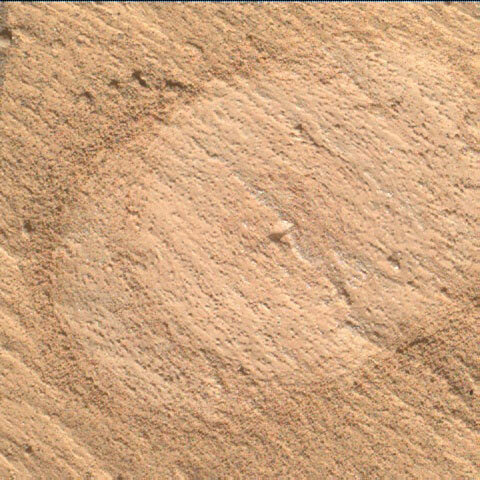3 min read

This weekend plan is an exciting one - we are "GO" for drilling! I worked as a Rover Planner today, helping to sequence our 34th drill hole on Mars on the target "Zechstein." This is also our 40th sample, including the six sand analyses we have done after scooping. In the last plan, we got a beautiful brush of the rock surface around Zechstein (shown in the image). We even think we can see a divot in the center resulting from our preload test, which is done to make sure the rock will not break when we try to drill.
Today, the first sol of the plan is all about the drill. First, we are using the APXS contact sensors to find the surface and then MAHLI to take imaging of all the targets we will need later in the campaign to dump out the sample. We have to do this because once we have sample we have to keep the drill pointed downward in order to avoid spilling the sample. We then start drilling in order to collect our sample. Other recent drilling activities have indicated the rocks are a little bit softer in this area, so we are hopeful that we will get a good sample for SAM and CheMin to analyze. After we drill, if there is enough time remaining, we will do some test sample portions on the SAM inlet cover to ensure that the sample is safe to give to the instruments – sticky samples or samples with lots of clumps may clog the inlets, so we always look at the samples before delivering. Overnight on the first sol, we will be doing an APXS measurement on the atmosphere. We are looking at the atmospheric composition, in particular Argon, which varies seasonally.
The second and third sols of the plan have targeted remote science observations. The drill tailings will be looked at closely with a Mastcam multispectral observation as well as a ChemCam RMI. We are looking at three spots around the target "Ardsheal" with Mastcam to look for recent changes in the sand and pebbles near the rover due to wind or temperature. We will follow up today’s observations with additional ones while we are parked during the drill campaign. There is also a large 28-frame mosaic of the Greenheugh pediment to help further characterize the capping layer, which is very distinctive, and to help plan the route ahead. For ChemCam, we are taking LIBS observations of a bedrock target "Causewayside" and a pebble target "Sannox" to get compositional comparisons of the two materials.
In addition to the targeted science, we have some additional environmental observations as well as some engineering maintenance activities. On the second sol we have a large dust devil movie, a 360-degree sky survey and a cloud observation with Navcam. On the third sol, in an early morning block a little more than hour after sunrise and just before the end of the plan, we have our standard AM Environmental suite: we take a Navcam zenith movie to look for clouds, a suprahorizon movie to look for clouds and dust devils, and some observations to measure the amount of dust in the atmosphere (a north-facing line of site toward the crater rim and a Mastcam solar tau sun image).
Written by Ashley Stroupe, Mission Operations Engineer at NASA's Jet Propulsion Laboratory







